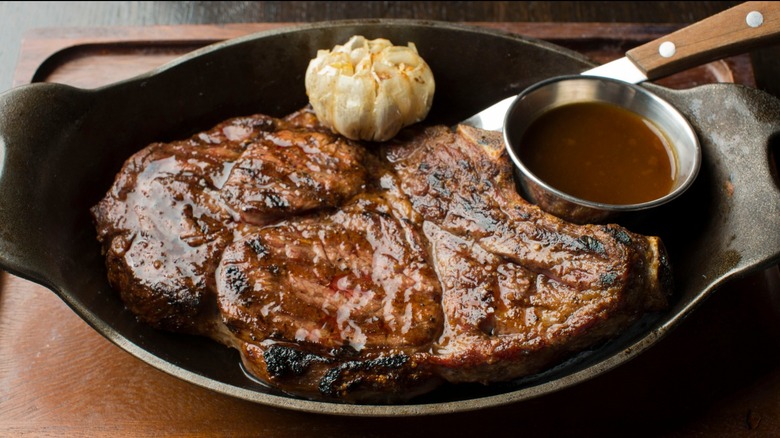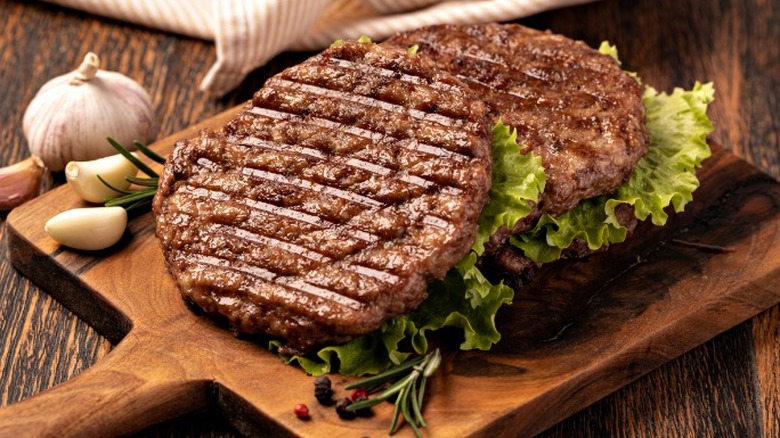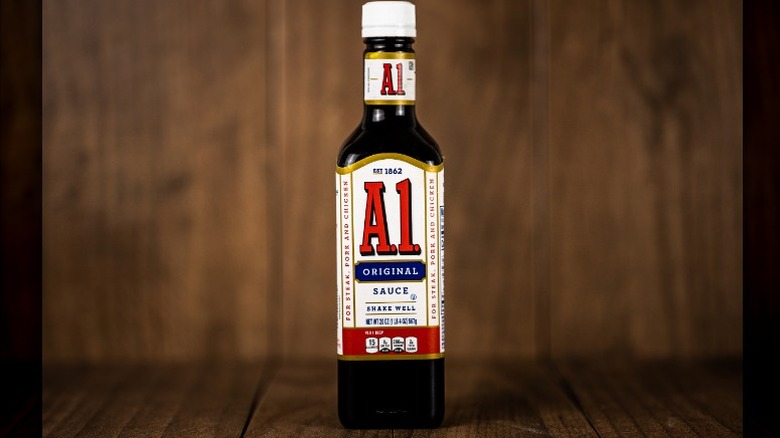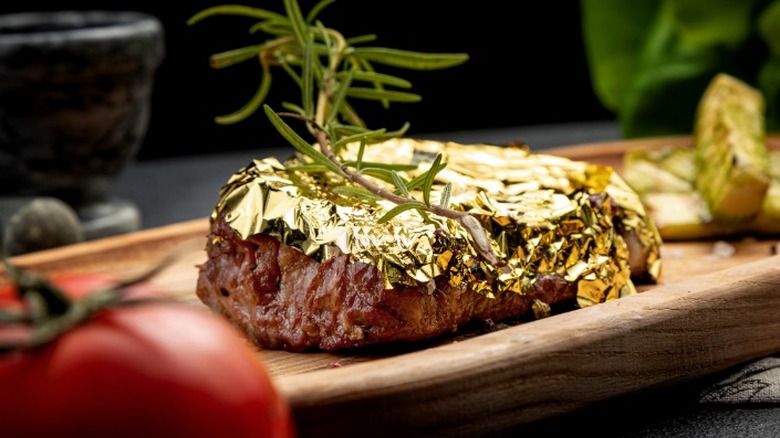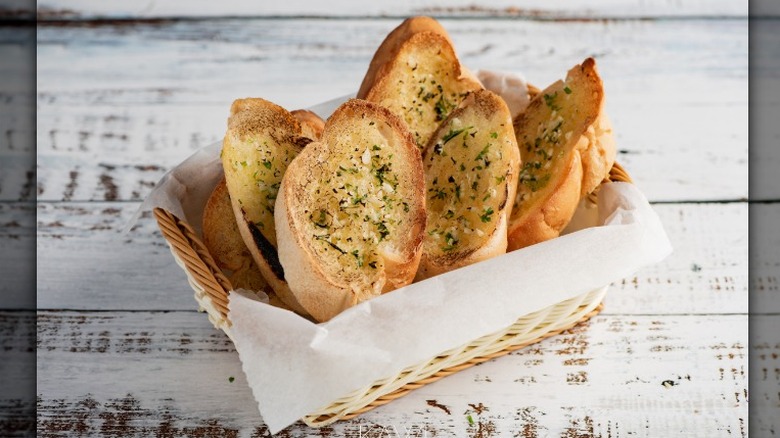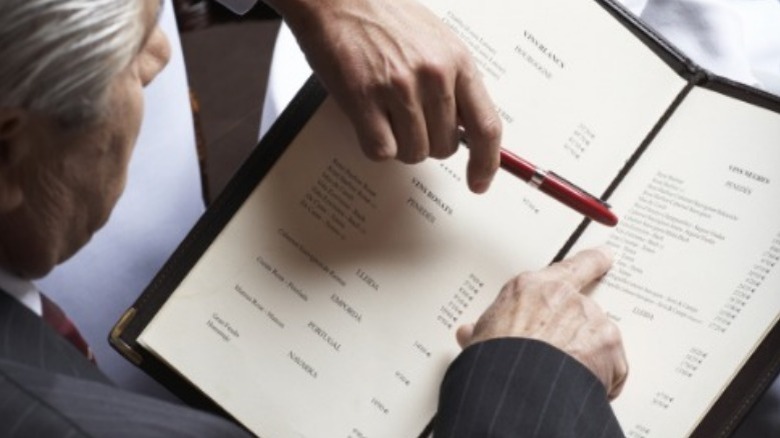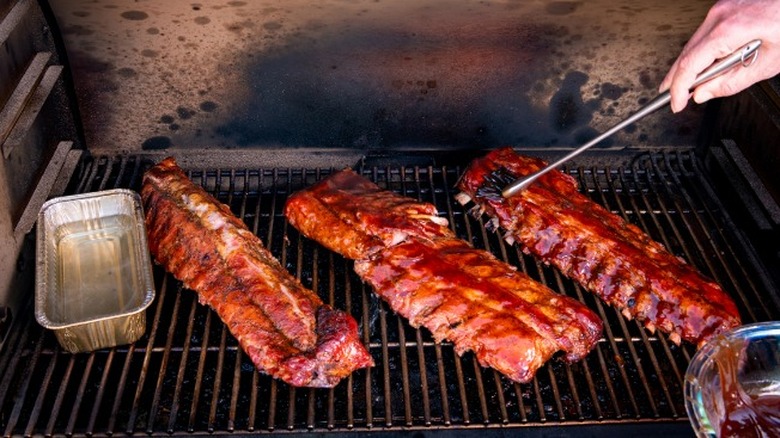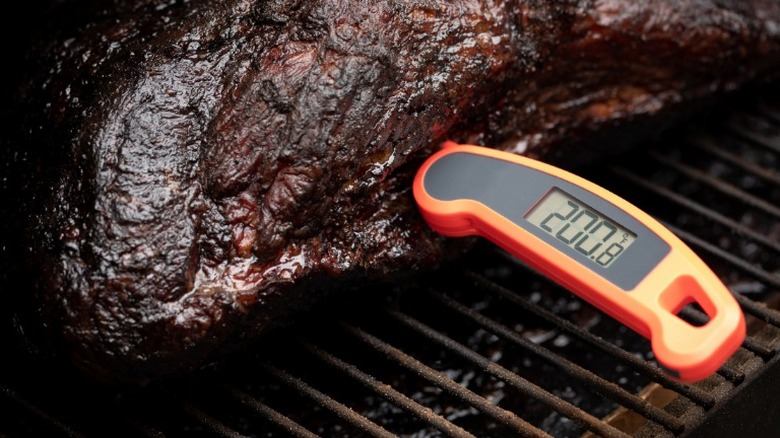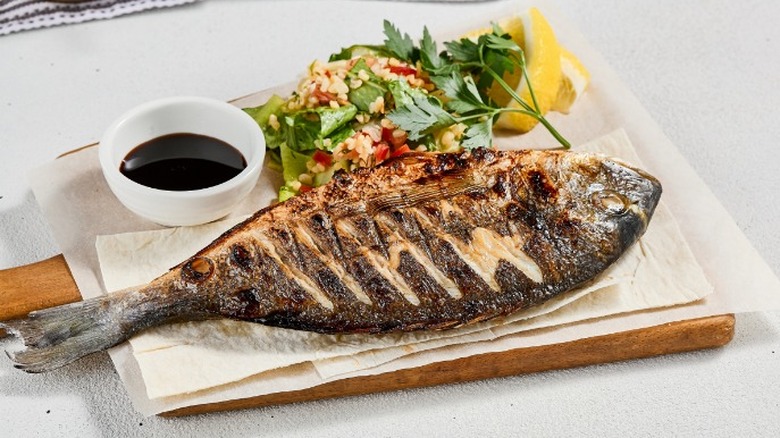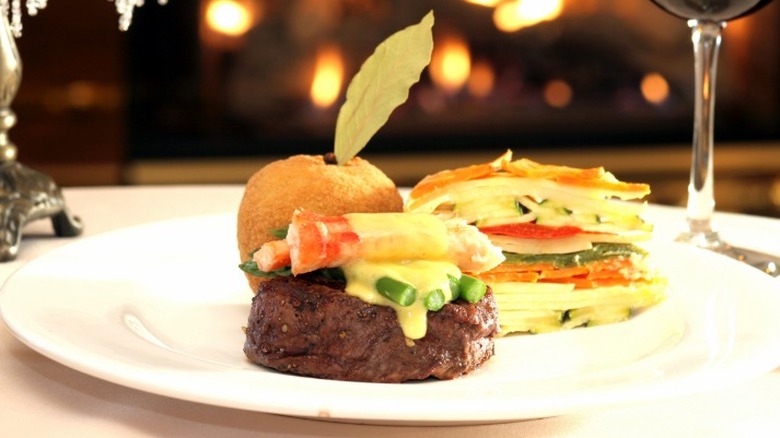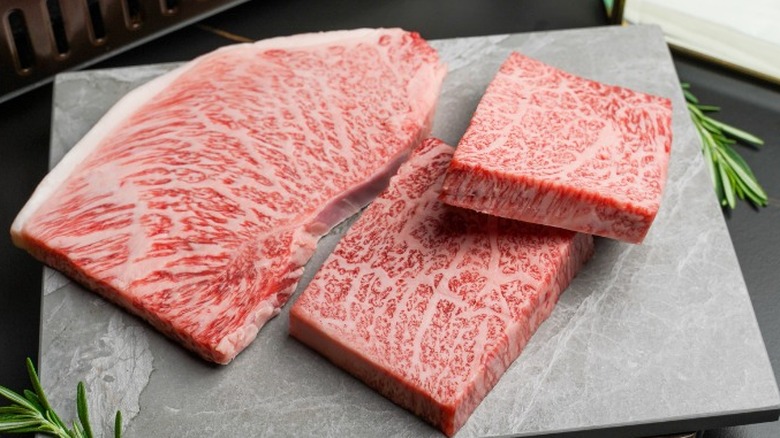10 Things You Might Want To Steer Clear Of At A Steakhouse
A good night out is often begun by venturing out to your favorite steakhouse or possibly trying a new one. While a good steak can be ordered at many restaurants, a steakhouse is set apart by specializing in that one cuisine along with the sides that traditionally accompany a good hunk of beef. The range of quality of a steakhouse is as varied as the cultures from around the country, including everything from the low end at the Golden Corral to the crème de la crème Ruth's Chris. Whether the establishment you choose holds a Michelin star or is more deserving of a greasy spoon award, a steakhouse dining experience is meant to be the highlight of a night out.
Typical steakhouses obviously serve steak, but the variety of entrees and sides can swing wildly depending on the restaurant and location, with local culture heavily influencing the selection. Most of them offer some kind of potato, vegetable, and salad along with appetizers from stuffed mushrooms to crab cakes. Expect to get a good fill from any of them and take caution not to overdo it, as that's far too easy with a delicious meal. Also, while most steakhouses limit the menu to five to seven cuts of steak and usually a chicken offering, some proprietors and chefs like to think outside of the box with menu preparation, for better or worse. Sadly, many times this menu development is for the worse, and you probably will not know until it is too late. Therefore, in the interest of public service, here are 10 things you may want to steer clear of at a steakhouse.
1. Chopped steak
Some folks get out to a steakhouse often and run into their favorite spot knowing exactly what to order before setting foot in the door. That does not describe most of us, who treat the opportunity to dine at a good steakhouse as a special night out. That said, menus can be intimidating, especially at high-end places where meals can easily run into the $50 range and higher. It is good to be prepared before setting out to avoid sticker shock. However, sticker shock is often what prompts patrons to order the chopped steak as it is usually the least expensive item on the menu, but there is good reason for this.
On some of these menus, everything can look appetizing. If you do happen to see chopped steak on the menu, know that this is nothing but a hamburger patty, and that is why it will be the cheapest option. There is nothing wrong with having a grilled hamburger patty, but the price will be significantly more than what you might find reasonable in another setting. It would be best to pony up a few more dollars and go for the sirloin or ribeye and get the best of your experience. According to The Tipsy Housewife, chopped steak is also kind of an old-school type of recipe, so it probably won't show up at the more progressive eateries in Soho or Tribeca.
2. Steak sauce
One of the more contentious culinary subjects that has been litigated for years involves the old standby condiment of steak sauce. A couple of the most popular labels include A.1. and Heinz 57 –- although HP is the go-to for our British friends –- but the options of liquids meant for grilled beef are virtually limitless. We have previously presented a definitive steak sauce guide featuring a rundown of the huge variety of sauces including bottles from the store and the more delectable made-to-order variety, so the conversation can go in a myriad of directions. However, as a general rule, don't ask for steak sauce at a steakhouse.
The roots of steak sauce extend back into the 1800s and the story has evolved greatly since then. A.1. wasn't declared to be specifically for steak until decades after its introduction. But there is a good reason not to ask for it, although fresh-made sauces from the kitchen are exempt from this discussion. The most upscale steakhouses employ chefs who get paid well to create the most delicious entrees to be delivered to your table. A good steak should have all the flavor it needs bursting from within. Choosing to add a dollop of processed liquid will not only change the natural flavors of the steak, but it will also overpower it. Furthermore, some chefs will see it as an insult. As a caveat and maybe a warning, if you find yourself in a questionable establishment that hasn't cleaned its bathrooms in years and the T-bone is suspiciously affordable, the sauce may be your best friend.
3. The golden calf
Unless you live in a blissfully unaware hole where trends on TikTok do not permeate your existence, you've probably heard the term Salt Bae. For the uninitiated, Salt Bae comes from the guy trending in videos showing him salting steaks tableside by sprinkling it down the backside of his forearm and onto the plate. It is dramatic, but serves no purpose. The infamous Salt Bae chef is Nusret Gökçe, a Turkish restaurateur with ultra-luxe locations in places such as Ankara, London, and Beverly Hills. Prices at these establishments are insanely high, including the signature Golden Tomahawk.
The only thing of note about this golden bone-in wagyu ribeye is that it is covered in gold before being served and it costs $1,160. Without the gold, it is $275, but reviews don't show it is even worth that. Complex UK reports that its London location is ranked as one of the worst. And here's the rub about the tomahawk. Gold does not enhance the flavor of food, only the price. It is certainly flashy, but a good pat of butter will do more to enhance the flavor of your beef. Guga Foods on YouTube tried the golden tomahawk and then recreated it to compare to one of their traditionally cooked cuts of beef. Not only did the gold not enhance the steak, but there was also no discernible difference.
4. Bread
Eating out is expensive and it is a special occasion for most people. This is especially true when visiting an upscale restaurant. However, one of the unique quirks of a steakhouse is that many exist that are not necessarily fine dining, but still have prices as if they are. Some of the best and most expensive steakhouses around the country are casual affairs with unique and quirky themes and décor. The Spudder steakhouse in Tulsa, Oklahoma is a perfect example of a kitschy place with an oilfield theme where you can wear blue jeans and spend a fortune.
The Spudder and countless restaurants like it serve bread family-style to the table, which leaves an ever-present temptation within reach of hungry patrons. While the rolls may be delectable and of fine quality, they should be a temptation kept at bay. As a carbohydrate, bread can actually increase hunger and that is a reason many restaurants offer it. Conversely, if you eat too much of it, you won't have room for your whole meal. A roll or two with the meal is a fine addition, but don't let it spoil your appetite before you get started.
5. Huge menus
The reason you visit a steakhouse should be apparent from the name, steak. Other places offer steak, but the cuts are usually limited, and a steakhouse should be the place to go where diners can choose from a list of all of the best cuts of beef that are well-suited to be grilled or seared to perfection. The quality of the meat can vary depending on the establishment, but the basics should be consistent throughout them all. Yet, some proprietors and chefs have difficulty staying in their lane and may venture out of what should be their comfort zone with the menu.
A steakhouse should have a ribeye, strip, filet, T-bone, and a chicken offering at a minimum. Most places will offer a few more things like lamb, pork, or even some seafood. But if you sit down and are greeted to a menu that reads like a newspaper with several pages of food offerings, you might want to reconsider. Huge menus are a sign the restaurant is trying to be something it isn't. Attempts to please everyone all the time usually end in pleasing nobody and quality goes downhill fast. Cooking a large menu usually results in having too many frozen ingredients and reheating of items, resulting in poor quality and slow service. It is important to have a specialty and stick to it because someone trying to do too much at once will eventually fail at everything.
6. Ribs
Short ribs and spare ribs are both excellent choices for a hearty meal –- Applebee's riblets are not included in this discussion. They are best when slow-cooked in a smoker over a long time to give them the most flavor while remaining moist and gaining peak tenderness. Good ribs can be found anywhere, and the best places to get them are general barbecue joints, particularly across the South.
A pitmaster is a person to go to for recommendations on how to cook ribs, as they are the professionals of the barbecue world where a lot of smoke and slow, steady heat are the keys to successful food. But they usually don't work at a steakhouse. You want a chef and a good sous chef or grill cook to watch over the steaks to ensure they get cooked to perfection without going too long. You won't find too many smokers or barbecue pits in a nice steakhouse, so the ribs will likely be oven baked and then grilled or some other combination of cooking styles. They may be delicious, but they won't be the chef's specialty. If you have a taste for ribs, find a good local barbecue place and come to the steakhouse later for a prime cut of beef.
7. Overcooked beef
This will be by far the most contentious subject broached when discussing steaks. One of the unique features of a steak is the ability to cook it to a range of temperatures and have a piece of food that remains just as edible throughout the whole range. Personal taste plays a big factor in how to cook one's steak and that decision can, to some, get rather personal.
Rare steaks are cooked to a temperature of about 125 degrees and a well-done, or fully-cooked, steak will hit around 170. Most chefs will agree a perfectly cooked steak should be medium-rare to medium to retain the most flavor and juiciness of the meat. Some diners are put off by the juice, usually due to the misconception that it is blood, but it is just the protein myoglobin found in muscles. When steaks are cooked above medium, they lose the juice and a lot of the flavor tends to leave with it. This is why so many chefs urge you to order your steak at a lower temperature to fully experience the quality of the cooking. However, people's taste in food is personal, so take this as a strong recommendation and do what pleases you next time you find yourself at a steakhouse.
8. Fish
Ordering fish from a steakhouse can be a bit like playing culinary craps. Every restaurant will have its own way of doing things and some will be better than others, that's kind of human nature. We are a bunch of flawed and unique individuals with different strengths and weaknesses. That characteristic is probably why we tend to gravitate toward a specific skill and specialize in it. For a chef, this is a key part of becoming successful and important to creating a great restaurant.
Since a steakhouse specializes in steak, that is going to be where its best efforts show on the plate. Most of them will offer some varieties of seafood to cater to various diets and tastes and these options can be delicious. However, the seafood from a steakhouse should only be ordered from top-rated establishments with a skilled chef at the helm. Otherwise, it will most likely be a frozen variety of low quality and cooked with less care than the specialty, the beef. In Reader's Digest, chef Mark Nichols advises staying away from seafood that is more than 100 miles from the ocean. Only fish handled fresh and delivered promptly to the kitchen will have the best quality. Anything else will be frozen and lose some of the texture and flavor. Besides, if you are in Kansas City or Dallas, you are closest to the ranches so why not take advantage of the local livestock and enjoy a good porterhouse? If you venture out to Amarillo, try The Big Texan for free, providing you finish their 72-ounce steak in an hour.
9. Hollandaise
Few sauces hold the stature and mystique of hollandaise. A simple sauce made primarily from butter and egg yolks with a bit of lemon, hollandaise is one of those things that can be great when done right, but is terrible when it is not and there almost is no middle ground. The difficulty with this sauce is that it must be made and held within a slim temperature range or it can break, meaning the main ingredients separate into solids, leaving a mess of butter with egg chunks.
Hollandaise is popular with classic dishes such as eggs benedict or steak Oscar, and good chefs will prepare it to order for each dish. Some busy establishments that prioritize fast service and high volume over individual quality of meals may use a prepared hollandaise product that comes frozen in a bag. This should be avoided at all costs. Furthermore, the late Anthony Bourdain said in an interview with The Guardian that hollandaise is a favorite breeding ground of bacteria. The temperatures required to hold the sauce for any length of time provide the perfect opportunity for bacteria to reproduce and completely ruin your life for a couple of days after ingesting tainted sauce. Unless you are completely satisfied that the chef where you are eating insists on the highest of standards, avoid this sauce.
10. Wagyu
One of the hottest culinary trends of the last decade or so has been the exotic and often misunderstood Japanese delicacy that is Kobe, or Wagyu, beef. It's said to be an ultra-high-grade of beef that comes from specific cattle raised in Japan, supposedly while being massaged and fed sake mash before slaughter. While a top grade of beef does exist in Japan, much of the tale surrounding its production is a myth.
Bon Appétit tells us that Japan has one of the strictest grading systems in the world for beef. Wagyu refers to four Japanese breeds, and the beef that comes from this cattle is distinctive for its higher-than-usual fat content throughout the muscle, called marbling. This is what chefs are looking for. Kobe is the highest quality of all Wagyu, and it comes from a few select bulls that are maintained by the Hyogo prefecture government. However, the descriptions of livestock being played classical music and such are mostly just stories. They're just cattle. Kobe can only be found in a few U.S. restaurants and it's estimated that given the average beef intake of Americans, the amount of genuine Kobe imported into the country is merely enough to feed 77 people.
The most important takeaway from what Bon Appétit tells us is that genuine Wagyu is hard to find. Some of it does come from cattle crossbred with some strains of the Japanese livestock, but most of it is just a marketing ploy. It may even be a delicious and high-quality steak, but it probably isn't Wagyu and almost certainly isn't Kobe. Stick with USDA Prime for your next ribeye.
